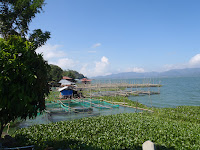After leaving Tangkoko Reserve we passed by a small coconut processing operation where we learned about how many uses there were for coconut trees. The wood from the trunk is used for furniture, the roots are used as coals for kilns, the husk is used for fire wood, woven mats, and filling for upholstery and then of course there is the meat, juice and oil all used for consumption. What a useful tree.
Moving on, we entered a small town where we saw many homes with cloves drying on tarps outside on the patios. We were also taken to a cemetery where the government had moved many ancient tombstones.
Leaving the town behind, we made our way up through the Minihasa highlands. We stopped by a couple of caves that were used by the Japanese during WW11. Inside the caves were several tunnels. Shining my light into one of the tunnels I noticed several pairs of beady red eyes staring back at me from the ceiling and walls. Upon closer inspection we discovered they belonged to huge rather ghastly looking spiders. Our guide assured us that they weren’t poisonous – still we all jumped when one of them scampered toward us while taking its picture. Another one of the caves inhabitants was swallows. These were the swallows whose nests they use for birds nest soup. There were several nests along the ceiling with baby birds in them.
From the caves we continued up through a stunning array of agricultural settings. There were immaculately terraced gardens that sported a wide variety of vegetables. Spice trees (clove, vanilla, nutmeg, and cinnamon) were growing right beside the road.
Our next stop was a traditional Minihasan market. This was the first of our sights that revealed some startling cultural differences. There was a lovely display of many fruits and vegetables, but when we came to the meat section there were fruit bats and dogs. Our guide confirmed that many of the people eat bats, rats and dogs on special occasions. Sometimes they even eat their own dog, but often they will go to a neighbor or another village and request to purchase someone’s dog. He said sometimes they also eat cats, but that the cats are less often consumed as they are considered useful in controlling the rat population. Hmmmm….. Ok moving on to a happier topic.
As luck would have it (with us all feeling slightly nauseous), our next stop was lunch. We stopped at restaurant on the banks of a large lake. Luckily, we had no unidentifiable meat on the menu. All around the lake were homes with fish farms and oddly there was almost nobody out on the lake.
We had 2 more stops to try and squeeze in as our incredibly full day was coming to an end. We breezed by Lake Linow known as the color changing lake. It is a volcanic lake that changes color from red to yellow, green, and blue. It is surrounded by exotic looking pine trees and has beautifully manicured grounds – perfect for a picnic.
Our final stop was to see prefab traditional Indonesian-style homes. They can be purchased for $5000.00 - $20,000.00 depending on the size and shipped anywhere in the world. They are made primarily from a local wood called Iron Wood.
Whew!!!! It was a lot of things to see in one day, but what an incredible experience.













No comments:
Post a Comment